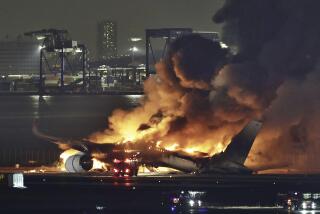Air Crews Can’t Smoke Out Jet Cracks
- Share via
WASHINGTON — The recently imposed smoking ban on many commercial flights has had one distinctly unhealthy side effect--it snuffed out the most popular method mechanics have used to spot cracks in aircraft fuselages.
Up until April when the government banned lighting up on flights of two hours’ duration or less, mechanics could count on tell-tale build-up of nicotine around cracks as air escaped from the passenger cabin when the plane pressurized after lift-off.
The cracks, which often are not dangerous as long as they remain small and do not link up, generally were repaired when the plane went in for maintenance.
But with the smoking ban, the nicotine is gone on many types of aircraft used in shorter flights such as DC-9s and Boeing 727s and 737s, and mechanics must now rely on much closer visual inspections and in some cases electronic inspections to detect cracks.
More to Read
Inside the business of entertainment
The Wide Shot brings you news, analysis and insights on everything from streaming wars to production — and what it all means for the future.
You may occasionally receive promotional content from the Los Angeles Times.










